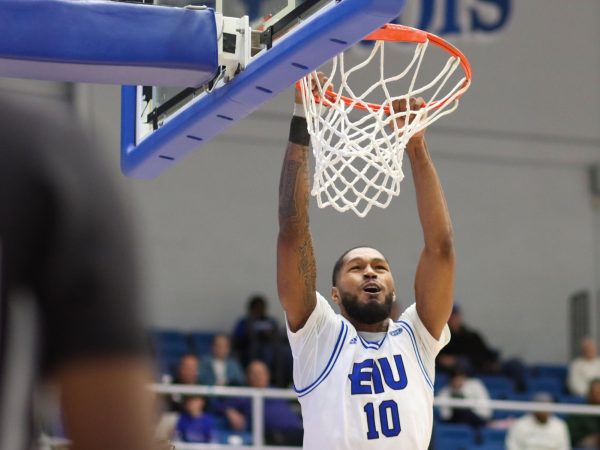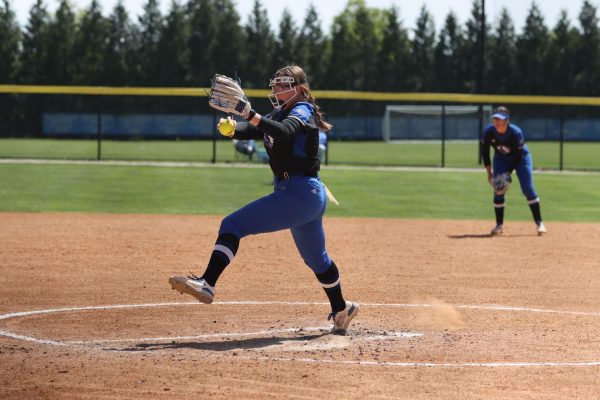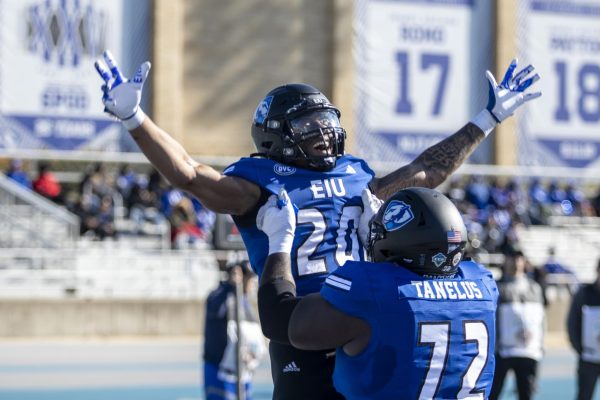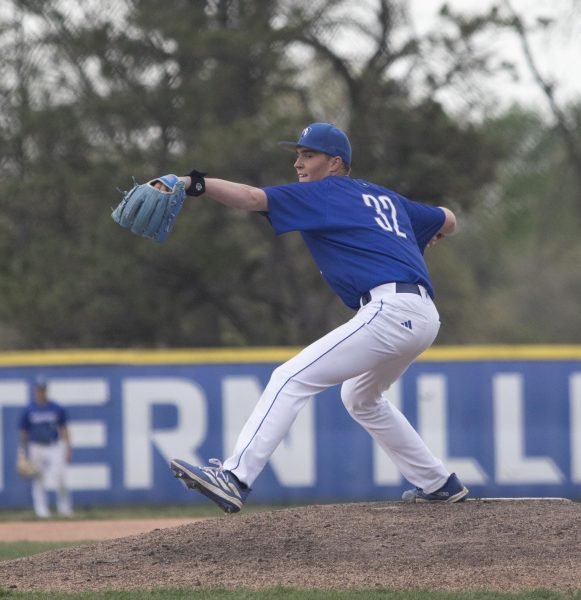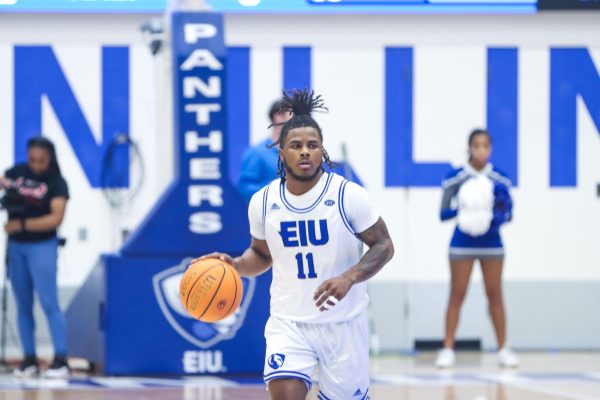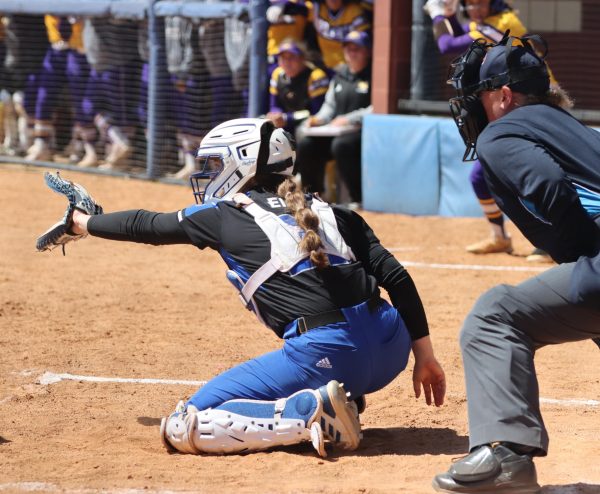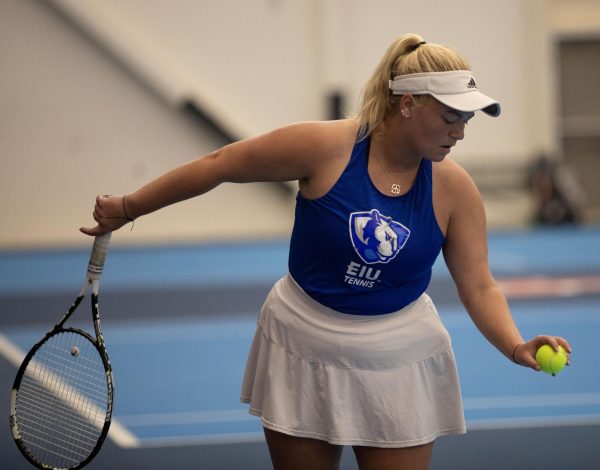Athletic budget exceeds $3 million
Sophomore cross country runner Stephanie Bone needs a new pair of shoes – five to be exact.
Over the course of the track and cross country seasons, Bone runs through five pairs of shoes and several spikes. Running on old pairs causes injuries, Bone said.
Eastern provides one pair and two sets of spikes and Bone estimated the cost for a pair of shoes at $100.
Men’s and women’s cross country and track teams were budgeted $107,000 collectively, a $22,000 increase from six years ago.
“We think we’re pretty nicely funded,” Panther cross country coach John McInerney said. “I hear other coaches from other schools complaining about how bad things are there all the time, so I think we’re OK.”
Many other schools don’t have a line item for cross country and instead use some of the track teams’ budget. At Eastern, women’s cross country was budgeted $10,500 while the men received $9,500. Bone said she sees a long road ahead.
“There are some guys on the cross country team, who work really hard and they’re in the top seven, but they don’t get any money,” Bone said.
Jake Stout, a freshman on the cross country team said he doesn’t see any financial problems on his team.
“It’s not really a spectator sport,” Stout said. “So I don’t think a lot of people really care for cross country so it doesn’t get much support.”
Bone has never seen a balance sheet and doesn’t care, but she said she could see where more money in the athletic department exists.
“I know that other guys from other sports go out and have steak dinners while we have to eat fast food before a meet,” Bone said. “But I understand all that. It’s not like we’re not able to compete and go to the meets we want to.”
Football carries the meat of the budget and revenue from it supplies much of the funding for the rest of the school’s 22 sports. Determining how much money each sport receives is a process that begins almost immediately after the last fiscal year’s budget is finished.
“We started on this year’s budget back in September and October and we’re already looking at next year’s budget a little bit, but we can’t really plan anything,” said Eastern Director of Athletics Rich McDuffie said.
McDuffie takes pride in budget work. He began his career working at a university with a budget deficit.
“Every year the athletic department was taking a half million dollar deficit and they couldn’t figure out why,” McDuffie said. “When I got there, I took a look at it and they were expecting about $400,000 more in donations than they received – problem solved. And really that’s the key here, we don’t want to be a drain on the university.”
Eastern’s athletic department carries a balanced budget.
McDuffie takes several measures to determine which sport receives how much money.
McDuffie said most of the budget hierarchy hashes out through history. Each sport receives money on a level it has in previous years. McDuffie talks with coaches and trainers on a regular basis to determine a need for equipment.
McDuffie discusses the budget several times with associate and assistant directors of athletics Deborah Polca, Rodger Jehlicka and John Smith. Polca handles the bulk of the women’s sports, Jehlicka looks at the men’s and Smith breaks down the football budget.
The budget for FY 04 hasn’t been finalized yet because the state has yet to determine how much money Eastern will receive next year.
“That’s the thing that’s a real booger this year is that we don’t have the budget yet,” McDuffie said. “We have some idea, but we don’t know for sure and we don’t know where we might have to make cuts yet.”
What Eastern’s competition budgets for each sport also plays a factor. Panther teams in the Ohio Valley Conference would also receive larger operating budgets.
“It’s unfortunate that not all our sports are in the OVC, but we want to be competitive there,” McDuffie said. “To do that, you have to spend the money in your conference sports.”
The budget allocates money for the Pink Panthers, officiating, academic enrichment, home management, or maintenance, guarantees, promotions and brochures, postseason, equipment purchases, training programs, sports information, capital projects debt and special projects.
The special projects fund is the athletic department’s largest. The fund is used for special events such as the men’s basketball team’s trip to the Preseason NIT. The money is used and replenished throughout the year as needed.
Academic enrichment provides academic counseling for student-athletes and is funded by Eastern’s share of money from the CBS television deal to cover the NCAA men’s basketball tournament.
The budget must check out in terms of gender equity. Under the agreement reached in 1998 with the campus civil rights department, Eastern must fund men’s and women’s sports on a 60-40 basis. Sixty percent of Eastern’s 500 athletes are male and therefore, women’s sports must receive at least 40 percent of the total funding. Scholarship dollars are determined a similar way.
Coaches’ salaries set up loosely to the 60-40 rule, an area McDuffie said he’d like to increase.
Assistant coaches make a base salary of $15,000. Many head coaches don’t rank much higher and several make under $30,000, something McDuffie said he’d also like to change.
“When I got here, we had the baseball coach on a nine-month contract, which meant he couldn’t recruit during the summer months,” McDuffie said. “He had only one assistant coach and no graduate assistant with only seven or eight scholarships and he they still won the OVC championship.”
McDuffie received an 11-percent raise this year on top of the $109,400 he was budgeted. McDuffie earned 84,900 in 1998, his first full year as director of athletics. Since then, the athletic administration added three associate athletic directors, Smith, Jehlicka and David Kidwell.
In McDuffie’s tenure, the athletic department received three increases in student fees, but few coaches’ salaries saw significant increases.
McDuffie said the problem in increasing salaries is it relies on state appropriated money, which totaled $1.269 million last year of the department’s $3 million budget.
McDuffie said all sports create revenue, but football, as is the case at most schools, draws the most. Money football and basketball teams make goes into a general fund and is distributed among the other sports. McDuffie estimated football brings in $200,000 and men’s and women’s basketball each draw $100,000-$120,000 in revenue.
While softball doesn’t bring much revenue, it leads the rest of the athletic department in fund raising with close to $20,000 each year.
“The softball team really does a great job there,” McDuffie said. “They work so hard at that all year and it shows.”
Ray Padovan, Panther swim coach, said money has been much tighter in the past than it is now. His team had no scholarships in the mid-1980s.
“We would like to have more, but yes we are functioning,” said Padovan, who completed his 37th season at Eastern last winter. “We’d like to replace our travel bags and sweats. Other teams get to do that sort of thing more often, but it’s not really a big deal. (McDuffie) is trying to help everybody. We’re not the main priority, but we’re not getting shut out.”
Men’s swimming received a $23,600 operating budget this year while the women’s team received $25,600.
Because the football team plays in a different pool of money, Smith said the budgeting process is tedious.
“We’d like to do more, but Rich has added quite a bit,” Smith said. “We weren’t balancing our budget for awhile but now we are. We’re as strong as any I-AA program, that’s for sure.”
Smith said he couldn’t make a valid comparison to the rest of the conference because schools budget differently. For example, many schools use a separate line item for travel, or have the officiating paid for by each sport instead of a separate line item.
While the amount of funding the athletic department receives in the future is uncertain, McDuffie has definite plans. He said he wants to update the computers in the department, one-third of which are more than five years old.
He wants to increase coaching salaries, add another administrative assistant and spend more money on basketball.
“We’re looking into basketball pretty heavily,” McDuffie said. “We’re looking at what our competition is doing, where they are recruiting and trying to find out if we need to spend more money there to be more successful.”
So does more money spent equal more wins?
“It’s been my experience that if you want to be successful, you’ve got to spend the money,” McDuffie said.



































